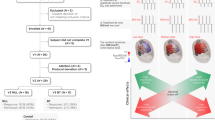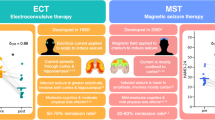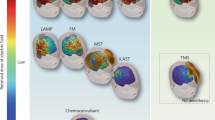Abstract
Electroconvulsive therapy (ECT) at conventional current amplitudes (800–900 mA) is highly effective but carries the risk of cognitive side effects. Lowering and individualizing the current amplitude may reduce side effects by virtue of a less intense and more focal electric field exposure in the brain, but this aspect of ECT dosing is largely unexplored. Magnetic seizure therapy (MST) induces a weaker and more focal electric field than ECT; however, the pulse amplitude is not individualized and the minimum amplitude required to induce a seizure is unknown. We titrated the amplitude of long stimulus trains (500 pulses) as a means of determining the minimum current amplitude required to induce a seizure with ECT (bilateral, right unilateral, bifrontal, and frontomedial electrode placements) and MST (round coil on vertex) in nonhuman primates. Furthermore, we investigated a novel method of predicting this amplitude-titrated seizure threshold (ST) by a non-convulsive measurement of motor threshold (MT) using single pulses delivered through the ECT electrodes or MST coil. Average STs were substantially lower than conventional pulse amplitudes (112–174 mA for ECT and 37.4% of maximum device amplitude for MST). ST was more variable in ECT than in MST. MT explained 63% of the ST variance and is hence the strongest known predictor of ST. These results indicate that seizures can be induced with less intense electric fields than conventional ECT that may be safer; efficacy and side effects should be evaluated in clinical studies. MT measurement could be a faster and safer alternative to empirical ST titration for ECT and MST.
Similar content being viewed by others
Log in or create a free account to read this content
Gain free access to this article, as well as selected content from this journal and more on nature.com
or
References
Awiszus F (2003) TMS and threshold hunting. In: Paulus W, Tergau F, Nitsche MA, Rothwell JC, Ziemann U, Hallett M (eds). Transcranial Magnetic Stimulation and Transcranial Direct Current Stimulation (Supplements to Clinical Neurophysiology). Elsevier Science: Amsterdam, The Netherlands. Vol 56, pp 13–23.
Boylan LS, Haskett RF, Mulsant BH, Greenberg RM, Prudic J, Spicknall K et al (2000). Determinants of seizure threshold in ECT: benzodiazepine use, anesthetic dosage, and other factors. J ECT 16: 3–18.
Chung KF (2002). Relationships between seizure duration and seizure threshold and stimulus dosage at electroconvulsive therapy: implications for electroconvulsive therapy practice. Psychiatry Clin Neurosci 56: 521–526.
Chung KF (2006). Determinants of seizure threshold of electroconvulsive therapy in Chinese. J ECT 22: 100–102.
Coffey CE, Lucke J, Weiner RD, Krystal AD, Aque M (1995). Seizure threshold in electroconvulsive therapy: I. Initial seizure threshold. Biol Psychiatry 37: 713–720.
Cycowicz YM, Luber B, Spellman T, Lisanby SH (2008). Differential neurophysiological effects of magnetic seizure therapy (MST) and electroconvulsive shock (ECS) in non-human primates. Clin EEG Neurosci 39: 144–149.
Cycowicz YM, Luber B, Spellman T, Lisanby SH (2009). Neurophysiological characterization of high-dose magnetic seizure therapy: comparisons with electroconvulsive shock and cognitive outcomes. J ECT 25: 157–164.
Deng Z-D, Lisanby S, Peterchev A (2014). Effect of anatomical variability on electric field characteristics of electroconvulsive therapy and magnetic seizure therapy: a parametric modeling study. IEEE Trans Neural Syst Rehabil Eng 23: 22–31.
Deng Z-D, Lisanby SH, Peterchev AV (2011). Electric field strength and focality in electroconvulsive therapy and magnetic seizure therapy: a finite element simulation study. J Neural Eng 8: 016007 (016013pp).
Deng ZD, Lisanby SH, Peterchev AV (2013). Controlling stimulation strength and focality in electroconvulsive therapy via current amplitude and electrode size and spacing: comparison with magnetic seizure therapy. J ECT 29: 325–335.
Edwards D, Cortes M, Datta A, Minhas P, Wassermann EM, Bikson M (2013). Physiological and modeling evidence for focal transcranial electrical brain stimulation in humans: a basis for high-definition tDCS. Neuroimage 74: 266–275.
Fitzgerald PB, Hoy KE, Herring SE, Clinton AM, Downey G, Daskalakis ZJ (2013). Pilot study of the clinical and cognitive effects of high-frequency magnetic seizure therapy in major depressive disorder. Depress Anxiety 30: 129–136.
Fleiss JL (1986) The Design and Analysis of Clinical Experiments. John Wiley & Sons: New York.
Galvez V, Hadzi-Pavlovic D, Smith D, Loo CK (2015). Predictors of seizure threshold in right unilateral ultrabrief electroconvulsive therapy: role of concomitant medications and anaesthesia used. Brain Stimul pii: S1935-861X(14)00449-5. doi:10.1016/j.brs.2014.12.012 (e-pub ahead of print).
Goodman WK (2011). Electroconvulsive therapy in the spotlight. N Engl J Med 364: 1785–1787.
Götz S, Whiting PA, Peterchev AV (2011). Threshold estimation with transcranial magnetic stimulation: algorithm comparison. Clin Neurophysiol 122: S197.
Kayser S, Bewernick B, Axmacher N, Schlaepfer TE (2009). Magnetic seizure therapy of treatment-resistant depression in a patient with bipolar disorder. J ECT 25: 137–140.
Kayser S, Bewernick BH, Grubert C, Hadrysiewicz BL, Axmacher N, Schlaepfer TE (2011). Antidepressant effects, of magnetic seizure therapy and electroconvulsive therapy, in treatment-resistant depression. J Psychiatr Res 45: 569–576.
Kayser S, Bewernick BH, Matusch A, Hurlemann R, Soehle M, Schlaepfer TE (2015). Magnetic seizure therapy in treatment-resistant depression: clinical, neuropsychological and metabolic effects. Psychol Med 45: 1073–1092.
Kellner CH, Knapp R, Husain MM, Rasmussen K, Sampson S, Cullum M et al (2010). Bifrontal, bitemporal and right unilateral electrode placement in ECT: randomised trial. Br J Psychiatry 196: 226–234.
Kim C, Yokozuka M, Sato C, Nakanishi K, Kitamura A, Sakamoto A (2007). Incessant non-sustained ventricular tachycardia after stimulus of electroconvulsive therapy with atropine premedication? Psychiatry Clin Neurosci 61: 564–567.
Kirov G, Ebmeier KP, Scott AI, Atkins M, Khalid N, Carrick L et al (2008). Quick recovery of orientation after magnetic seizure therapy for major depressive disorder. Br J Psychiatry 193: 152–155.
Kosel M, Frick C, Lisanby SH, Fisch HU, Schlaepfer TE (2003). Magnetic seizure therapy improves mood in refractory major depression. Neuropsychopharm 28: 2045–2048.
Lee WH, Deng ZD, Kim TS, Laine AF, Lisanby SH, Peterchev AV (2012). Regional electric field induced by electroconvulsive therapy in a realistic finite element head model: influence of white matter anisotropic conductivity. Neuroimage 59: 2110–2123.
Lee WH, Lisanby SH, Laine AF, Peterchev AV (2013a). Anatomical variability predicts individual differences in ECT seizure threshold: a combined preclinical and computational modeling study. J ECT 29: 150–151.
Lee WH, Lisanby SH, Laine AF, Peterchev AV (2013b). Electric field characteristics of electroconvulsive therapy with individualized current amplitude: A preclinical study. Conf Proc IEEE Eng Med Biol Soc 2013: 3082–3085.
Lee WH, Lisanby SH, Laine AF, Peterchev AV (2015). Electric field model of transcranial electric stimulation in nonhuman primates: Correspondence to individual motor threshold. IEEE Trans Biomed Eng (e-pub ahead of print 22 April 2015, doi:10.1109/TBME.2015.2425406.
Lee WH, Lisanby SH, Laine AF, Peterchev AV (2014). Stimulation strength and focality of electroconvulsive therapy and magnetic seizure therapy in a realistic head model. Conf Proc IEEE Eng Med Biol Soc 2014: 410–413.
Liberson WT (1945). Time factors in electric convulsive therapy. Yale J Biol Med 17: 571–578.
Liberson WT (1948). Brief stimulus therapy—physiological and clinical observations. Am J Psychiatry 105: 28–39.
Liberson WT (1953). Current evaluation of electric convulsive therapy; correlation of the parameters of electric current with physiologic and psychologic changes. Res Publ Assoc Res Nerv Ment Dis 31: 199–231.
Lisanby SH, Luber B, Schlaepfer TE, Sackeim HA (2003a). Safety and feasibility of magnetic seizure therapy (MST) in major depression: Randomized within-subject comparison with electroconvulsive therapy. Neuropsychopharm 28: 1852–1865.
Lisanby SH, Moscrip TD, Morales O, Luber B, Schroeder C, Sackeim HA (2003b). Neurophysiological characterization of magnetic seizure therapy (MST) in non-human primates. Clin Neurophysiol Suppl 56: 81–99.
Lisanby SH, Schlaepfer TE, Fisch HU, Sackeim HA (2001). Magnetic seizure therapy of major depression. Arch Gen Psychiatry 58: 303–305.
Lyons JE, Symon J (2008). Asystole during electroconvulsive therapy in an elderly woman treated concomitantly with venlafaxine. Aust NZJ Psychiatry 42: 255.
Macdonald DB, Skinner S, Shils J, Yingling C (2013). Intraoperative motor evoked potential monitoring—A position statement by the American Society of Neurophysiological Monitoring. Clin Neurophysiol 124: 2291–2316.
Moscrip T, Terrace HS, Sackeim HA, Lisanby SH (2004). A primate model of anterograde and retrograde amnesia produced by convulsive treatment. J ECT 20: 26–36.
Moscrip TD, Terrace HS, Sackeim HA, Lisanby SH (2006). Randomized controlled trial of the cognitive side-effects of magnetic seizure therapy (MST) and electroconvulsive shock (ECS). Int J Neuropsychopharmacol 9: 1–11.
Nahas Z, Short B, Burns C, Archer M, Schmidt M, Prudic J et al (2013). A feasibility study of a new method for electrically producing seizures in man: focal electrically administered seizure therapy [FEAST]. Brain Stimul 6: 403–408.
Peterchev AV, Chan B, Lisanby SH (2010a). Pulse amplitude adjustment: a novel means of individualizing and predicting dosage requirements for electroconvulsive therapy and magnetic seizure therapy. J ECT 26: 154–155.
Peterchev AV, Rosa MA, Deng ZD, Prudic J, Lisanby SH (2010b). Electroconvulsive therapy stimulus parameters: rethinking dosage. J ECT 26: 159–174.
Peterchev AV, Wagner TA, Miranda PC, Nitsche MA, Paulus W, Lisanby SH et al (2012). Fundamentals of transcranial electric and magnetic stimulation dose: definition, selection, and reporting practices. Brain Stimul 5: 435–453.
Qi F, Wu AD, Schweighofer N (2011). Fast estimation of transcranial magnetic stimulation motor threshold. Brain Stimul 4: 50–57.
Rasimas JJ, Stevens SR, Rasmussen KG (2007). Seizure length in electroconvulsive therapy as a function of age, sex, and treatment number. J ECT 23: 14–16.
Rosa MA, Abdo GL, Lisanby SH, Peterchev AV (2011). Seizure induction with low-amplitude-current electroconvulsive therapy. J ECT 27: 179.
Rosa MA, Abdo GL, Rosa MO, Lisanby SH, Peterchev AV (2012). Fronto-medial electrode placement with low current amplitude: a case report. J ECT 28: 146.
Rossini PM, Barker AT, Berardelli A, Caramia MD, Caruso G, Cracco RQ et al (1994). Non-invasive electrical and magnetic stimulation of the brain, spinal cord and roots: basic principles and procedures for routine clinical application. Report of an IFCN committee. Electroencephalogr Clin Neurophysiol 91: 79–92.
Sackeim HA (2004). Convulsant and anticonvulsant properties of electroconvulsive therapy: toward a focal form of brain stimulation. Clin Neurosci Res 4: 39–57.
Sackeim HA, Long J, Luber B, Moeller JR, Prohovnik I, Devanand DP et al (1994). Physical properties and quantification of the ECT stimulus: I. Basic principles. Convuls Ther 10: 93–123.
Sackeim HA, Prudic J, Nobler MS, Fitzsimons L, Lisanby SH, Payne N et al (2008). Effects of pulse width and electrode placement on the efficacy and cognitive effects of electroconvulsive therapy. Brain Stimulat 1: 71–83.
Semkovska M, McLoughlin DM (2010). Objective cognitive performance associated with electroconvulsive therapy for depression: A systematic review and meta-analysis. Biological Psychiatry 68: 568–577.
Spellman T, McClintock SM, Terrace HS, Luber B, Husain MM, Lisanby SH (2008). Differential effects of high-dose magnetic seizure therapy and electroconvulsive shock on cognitive function. Biol Psychiatry 63: 1163–1170.
Spellman T, Peterchev AV, Lisanby SH (2009). Focal electrically administered seizure therapy: A novel form of ECT illustrates the roles of current directionality, polarity, and electrode configuration in seziure induction. Neuropsychopharm 34: 2002–2010.
Streiner DL, Norman GR (1995) Health Measurement Scales: A Practical Guide to their Development and Use, 2nd edn. Oxford University Press: New York.
Swartz CM, Krohmer R, Michael N (2012). ECT stimulus dose dependence on current separately from charge. Psychiatry Res 198: 164–165.
Szelenyi A, Kothbauer KF, Deletis V (2007). Transcranial electric stimulation for intraoperative motor evoked potential monitoring: Stimulation parameters and electrode montages. Clin Neurophysiol 118: 1586–1595.
Tang WK, Ungvari GS (2001). Asystole during electroconvulsive therapy: a case report. Aust NZJ Psychiatry 35: 382–385.
Van Ness PH, Towle VR, Juthani-Mehta M (2008). Testing measurement reliability in older populations: methods for informed discrimination in instrument selection and application. J Aging Health 20: 183–197.
van Waarde JA, van Oudheusden LJ, Heslinga OB, Verwey B, van der Mast RC, Giltay E (2013a). Patient, treatment, and anatomical predictors of outcome in electroconvulsive therapy: a prospective study. J ECT 29: 113–121.
van Waarde JA, van Oudheusden LJ, Tonino BA, van der Wee NJ, Verwey B, van der Mast RC et al (2013b). MRI characteristics predicting seizure threshold in patients undergoing electroconvulsive therapy: a prospective study. Brain Stimul 6: 607–614.
van Waarde JA, van Oudheusden LJ, Verwey B, Giltay EJ, van der Mast RC (2013c). Clinical predictors of seizure threshold in electroconvulsive therapy: a prospective study. Eur Arch Psychiatry Clin Neurosci 263: 167–175.
Verwijk E, Comijs HC, Kok RM, Spaans HP, Stek ML, Scherder EJ (2012). Neurocognitive effects after brief pulse and ultrabrief pulse unilateral electroconvulsive therapy for major depression: a review. J Affect Disord 140: 233–243.
Acknowledgements
We thank Brian Chan, Niko Reyes, Mohamed Aly, Christopher Sikes-Keilp, and Nagy Youssef for assisting in the NHP procedures and data entry, Won Hee Lee and Zhi-De Deng for preparing Figure 1, Christopher Sikes-Keilp and Zhi-De Deng for EEG data processing, and Maragatha Kuchibhatla and Bruce Luber for data analysis advice. This study was supported by NIH grants R01MH091083 and R01MH060884 and with MST device loan from MagVenture. This work was presented, in part, in preliminary form at the annual meetings of the International Society for ECT and Neurostimulation in 2010 (Peterchev et al, 2010a), the American College of Neuropsychopharmacology in 2011 and 2013, and the Society of Biological Psychiatry in 2014.
Author information
Authors and Affiliations
Corresponding author
Additional information
Supplementary Information accompanies the paper on the Neuropsychopharmacology website
Supplementary information
Rights and permissions
About this article
Cite this article
Peterchev, A., Krystal, A., Rosa, M. et al. Individualized Low-Amplitude Seizure Therapy: Minimizing Current for Electroconvulsive Therapy and Magnetic Seizure Therapy. Neuropsychopharmacol 40, 2076–2084 (2015). https://doi.org/10.1038/npp.2015.122
Received:
Revised:
Accepted:
Published:
Issue date:
DOI: https://doi.org/10.1038/npp.2015.122
This article is cited by
-
How electroconvulsive therapy works in the treatment of depression: is it the seizure, the electricity, or both?
Neuropsychopharmacology (2024)
-
Amplitude-determined seizure-threshold, electric field modeling, and electroconvulsive therapy antidepressant and cognitive outcomes
Neuropsychopharmacology (2024)
-
Electroconvulsive therapy, electric field, neuroplasticity, and clinical outcomes
Molecular Psychiatry (2022)
-
Noninvasive neuromodulation of the prefrontal cortex in mental health disorders
Neuropsychopharmacology (2022)
-
Novel Stimulation Approaches with ECT: Why Everything Old May be New Again
Neuropsychopharmacology (2017)



